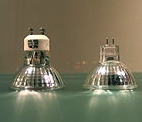
CEC Press Release: September 30, 2014
Media Contact: Amber Beck - 916-654-4989 916-654-4989
916-654-4989
California Lights the Way with Proposals for Energy-Efficient Lights
Improving Efficiency of Small Bulbs Generally Used in Track Lighting and Light-Emitting Diodes (LED)
Designed to Replace Incandescent Bulbs
Sacramento: The California Energy Commission released a draft staff report that shines a little light on the energy efficiency of small diameter directional lamps often used in commercial track lighting settings and light-emitting diodes (LEDs) that can replace screw-based incandescent bulbs typically found in homes.
[More on small diameter directional lamps]
"Rapid technology advances have produced highly energy-efficient, long-lasting light sources that are every bit as aesthetically pleasing as conventional lighting sources, and even more functional," said Commissioner Andrew McAllister, the agency's lead on energy efficiency issues. "Updating your older bulbs with modern versions is one of the easiest ways to save money and help our great state reach its energy goals."
To develop the report, the Energy Commission sought stakeholder input and proposals on standards, test procedures, labeling requirements, and other measures to reduce energy consumption.
The Energy Commission hosted a workshop yesterday to gather public input on the draft proposed standards in the report. Written comments on the proposal will be accepted through October 29. The purpose of the workshop and written comment period is to gather input before formally proposing new standards with a rulemaking. Final standards are expected to be adopted in 2015 and take effect no earlier than one year after adoption.
Small-diameter directional lamps, specifically multifaceted reflector lamps (MR-16s), are available in three technologies–halogen, halogen infrared reflecting (HIR) and LED. In California, about 16 million of these lamps are installed in existing buildings, and the stock is expected to grow to more than 20 million by 2028.
Energy Commission staff found a large variation in energy efficiency among lamps sold in California. Halogen bulbs start at 15 lumens per watt, while LEDs range from 40-90 lumens per watt and consume as little as one-sixth of the energy. Although LEDs are initially more expensive to purchase, the life of one LED lamp is about seven times greater than the life of one halogen lamp, so fewer lamps need to be purchased. Because LEDs consume much less energy than conventional lamps, the lifetime energy savings far exceeds the higher purchase cost. Energy Commission staff proposes that, effective January 1, 2018, all small directional lamps have an efficiency minimum of 80 lumens per watt and a rated life of nearly three years.
Lighting is estimated to consume 22 percent of residential electricity, according to the 2009 Residential Appliance Saturation Survey (RASS). There are about 600 million general-purpose lamps in residential buildings in California. Moving to high-efficiency LED lamps could cut the energy consumption of these bulbs to less than half.
The Energy Commission staff proposal focuses on three aspects of lamps: the efficiency, color rendering index (CRI), and color correlated temperature. The proposal allows for tradeoffs between the efficiency of a lamp and color rendering and would be implemented in two phases with the first on January 1, 2017, and a second more stringent phase on January 1, 2019. The proposal also includes labeling standards that require manufacturers to meet minimum thresholds before making claims about dimmability and applicability to retrofits of traditionally incandescent sockets.
# # #
The California Energy Commission is the state's primary energy policy and planning agency. Created by the Legislature in 1974 and located in Sacramento, six basic responsibilities guide the Energy Commission as it sets state energy policy: forecasting future energy needs; licensing thermal power plants 50 megawatts or larger; promoting energy efficiency and conservation by setting the state's appliance and building efficiency standards; supporting public interest energy research that advances energy science and technology through research, development, and demonstration programs; developing renewable energy resources and alternative renewable energy technologies for buildings, industry and transportation; planning for and directing state response to energy emergencies. For more information, visit: www.energy.ca.gov or www.energy.ca.gov/releases/.
Sign up for California Energy Commission news releases at http://www.energy.ca.gov/releases/.